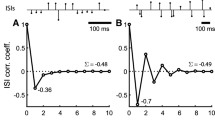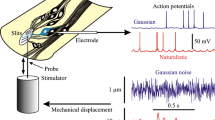Abstract
A recurrent excitation loop was constructed by enabling each impulse from the slowly adapting stretch receptor organ SAO (crayfish) to trigger through an electronic circuit a brief stretch, or “tug,” of the receptor. When applied independently, each tug influenced the discharge as would an EPSP. Recurrent excitation led to characteristic discharge timings; hence, even an isolated neuron can have intrinsic mechanisms that prevent positive feedback from freezing it in an extreme non-operational state. Such timings depended critically on the “phase”, i.e., on the time elapsed between an SAO impulse and the tug. When the control discharge was stationary (because the SAO length remained invariant), phases of a few ms simply changed the pattern to one of doublets, and affected little the average rate. As the phase increased, bursts appeared, bursts and interburst intervals became more prolonged, and average rates increased. With the largest phases examined (40 ms), the discharge consisted of a slow alternation of high rate bursts, separated by long intervals. When the discharge was modulated (by 0.2/s sinusoidal length variation) with recurrent excitation, the peak-to-peak rate swing, i.e., the sensitivity, and the proportion of the cycle without afferent discharges increased, and the rate vs. length display was distorted even though remaining “loop-plus-extension.” Changes were phase-dependent: for example, loops could have a sharp high peak at one phase and be flat-topped at another. When the interspike interval variability was exaggerated (by a length jitter superimposed upon either invariant or sinusoidally varying lengths), recurrent excitation exerted fewer, weaker and somewhat different effects: e.g., it reduced the overall intensity of the invariant cases and the peak-to-peak swing in the modulated one. The precise mechanisms of these results can only be conjectured at but are likely to involve an electrogenic pump, electromechanical interactions, topographical issues, as well as their interplays. The functional implications involve, for instance, the modulation of the intensity, duration and occurrence of the bursting patterns in oscillating functions (e.g., breathing, chewing, etc.).
Similar content being viewed by others
References
Bryant, Jr., H.L., Ruiz Marcos, A., Segundo, J.P.: Correlations of the neuronal spike discharges produced by monosynaptic connections and by common inputs. J. Neurophysiol. 36, 205–225 (1973)
Cajal, S.R. y.: Histologie du système nerveux de l'homme et des vertébrés. Madrid: CSIC Instituto Ramón y Cajal 1952
Calvin, W.H., Hartline, D.K.: Retrograde invasion of lobster stretch receptor somata in control of firing rate and extra spike patterning. J. Neurophysiol. 40, 106–118 (1977)
Diez Martínez, O.: Fast-adapting stretch receptor: periodic and steady-state stimulation with and without perturbation. University of California, Los Angeles, USA: Doctoral Thesis 1981
Diez Martinez, O., Kohn, A.F., Segundo, J.P.: Pervasive locking, saturation, asymmetric rate sensitivity double-valuedness in cray fish stretch receptors (in preparation)
Firth, D.R.: Interspike interval fluctuations in the crayfish stretch receptors. Biophys. J. 6, 201–215 (1966)
Fischer, W.: Untersuchungen zur jahreszeitlichen Veränderung des Antworterhaltens der langsam adaptierenden Dehnungsrezeptorzellen des Flußkrebses Orconectes limosus (RAF). Zool. Beitr. (Neue Folge) 26, 117–126 (1980)
Freeman, W.J.: A model for mutual excitation in a neuron population in olfactory bulb. IEE Trans. Biomed. Eng. 21, 350–358 (1974a)
Freeman, W.J.: Stability characteristics of positive feedback in a neural population. IEE Trans. Biomed. Eng. 21, 358–364 (1974b)
Grampp, W.: Firing with multiple-spike discharges in the slowly adapting stretch receptor neuron of the lobster. Acta Physiol. Scand. 66, 484–494 (1966a)
Grampp, W.: The impulse activity on different parts of the slowly adapting stretch receptor neuron of the lobster. Acta Physiol. Scand. 66, Suppl. 262 (1966b)
Hartline, D.K., Gassie, D.V.: Artificially cross-coupled tonic neurons produce alternating bursts. Neurosci. Abstr. 8, 739 (1982)
Kennedy, D., Davis, W.J.: Organization of invertebrate motor systems. In: Handbook of Physiology, Sect. 1, Chap. 27. The Nervous System. Vol. 1, Part 2, Brookhart, J.M., Mountcastle, V.B., Kandel, E.R., (eds.), Bethesda: APS 1977
Kohn, A.F., Freitas da Rocha, A., Segundo, J.P.: Presynaptic irregularity and pacemaker inhibition. Biol. Cybern. 41, 5–18 (1981)
MacGregor, R.J., Lewis, E.R.: Neural modelling. London: Plenum Press 1977
Perkel, D.H., Mulloney, B.: Motor pattern production in reciprocally inhibitory neurons exhibiting post-inhibitory rebound. Science 185, 181–183 (1974)
Pringle, J.W.S.: Proprioception in arthropods. In: The Cell and the Organism, Ramsey, J.A., Wigglesworth, V.D. (eds.). Cambridge: Cambridge University Press 1961
Renshaw, B.: Influence of discharge of motoneurons upon excitation of neighboring motoneurons. J. Neurophysiol. 4, 167–183 (1941)
Ringham, G.: Origin of nerve impulse in slowly adapting stretch receptor of crayfish. J. Neurophysiol. 34, 773–784 (1971)
Segundo, J.P., Kohn, A.F.: A model of excitatory synaptic interactions between pacemakers: Its reality, its generality, and the principles involved. Biol. Cybern. 40, 113–126 (1981)
Sokolove, P.G.: Crayfish stretch receptor and motor unit behavior during abdominal extension. J. Comp. Physiol. 84, 251–266 (1973)
Sokolove, P.G., Cooke, I.M.: Inhibitions of impulse activity in a sensory neuron by an electrogenic pump. J. Gen. Physiol. 57, 125–163 (1971)
Teorell, T.: A biophysical analysis of mechano-electrical transduction. In: Handbook of Sensory Physiology. Vol. 1, pp. 291–339. Principles of receptor physiology. Berlin, Heidelberg, New York: Springer 1971
Valverde, R.: The pyramidal tract in rodents. A study of its relations with the posterior column nuclei, dorsalateral reticular formation of the medulla oblongata, and cervical spinal cord. Z. Zellforsch. Mikrosk. Anat. 71, 297–363 (1966)
Vibert, J.F., Davis, M., Segundo, J.P.: Recurrent inhibition: its influence upon transduction and afferent discharges in slowly-adapting stretch receptor organs. Biol. Cybern. 33, 167–178 (1979)
Vibert, J.F., Segundo, J.P.: Slowly adapting stretch-receptor organs: periodic stimulation with and without perturbations. Biol. Cybern. 33, 81–95 (1979)
Wilson, V.J., Burgess, P.R.: Effects of antidromic conditioning on some motoneurons and interneurons. J. Neurophysiol. 25, 636–650 (1962)
Author information
Authors and Affiliations
Additional information
Supported by funds from the Brain Research Institute and by a fellowship to ODM from the Dept. de Becas, Dir. Gral. de Asuntos del Personal Académico, Universidad Nacional Autónoma de México (UNAM)
Rights and permissions
About this article
Cite this article
Martinez, O.D., Segundo, J.P. Behavior of a single neuron in a recurrent excitatory loop. Biol. Cybern. 47, 33–41 (1983). https://doi.org/10.1007/BF00340067
Received:
Issue Date:
DOI: https://doi.org/10.1007/BF00340067




